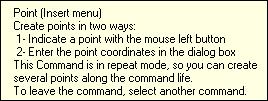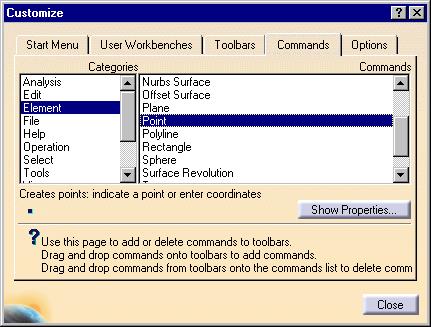

3D PLM Enterprise Architecture |
User Interface - Frame |
Creating Standard Command HeadersExposing your commands |
| Use Case | ||
AbstractThis article shows how to create a standard command header class, and how to use it to expose several commands. |
This use case is intended to show how to create a standard command header class, and how to use it to expose several commands.
[Top]
CAAAfrGeometryWshop is a use case of the CAAApplicationFrame.edu framework that illustrates the ApplicationFrame framework capabilities.
[Top]
The CAAAfrGeometryWshop use case creates a workshop named CAA V5: Geometry Creation for the CAAGeometry document [1]. It is used here only to show and detail how to expose the workshop commands thanks to command headers.
[Top]
See the section entitled "How to Launch the CAAGeometry Use Case" in the "The CAAGeometry Sample" use case for a detailed description of how this use case should be launched. For the specific scenario :
Do not type the module name on the command line, but type CNEXT instead. When the application is ready, do the following:
The CAAAfrGeometryWshop is loaded with the CAAGeometry document.
[Top]
The CAAAfrGeometryWshop use case is made of classes and interfaces located in the CAAAfrGeometryWshop.m module and in the ProtectedInterfaces directory of the CAAApplicationFrame.edu framework:
| Windows | InstallRootDirectory\CAAApplicationFrame.edu\CAAAfrGeometryWshop.m\ |
| Unix | InstallRootDirectory/CAAApplicationFrame.edu/CAAAfrGeometryWshop.m/ |
where InstallRootDirectory is the directory where the CAA CD-ROM
is installed.
The only class referred to in this article is the workshop description class named CAAAfrGeometryWks
[Top]
To create the command headers for the command of the Geometry workshop, there are three steps:
| # | Step | Where |
|---|---|---|
| 1 | Create the command header class | Workshop class |
| 2 | Instantiate the command header class | CreateCommands method |
| 3 | Assign Resources to the command header instance | Resource files |
[Top]
To create a command header class, you should use the MacDeclareHeader
macro. It creates for you a class that derives from CATCommandHeader,
that is the base class for command headers and that should never be directly
instantiated.
The command header class for the CAAAfrGeometryWks workshop is named CAAAfrGeometryWksHeader. The two lines of code below create this class.
#include "CATCommandHeader.h" MacDeclareHeader(CAAAfrGeometryWksHeader); |
This macro creates a class that is ready to use.
[Top]
To instantiate this command header for the Point command, for example, the following constructor created by the macro should be used.
new CAAAfrGeometryWksHeader("Point",
"CAADegGeoCommands",
"CAADegCreatePointCmd",
(void *) NULL);
|
where:
Point is the identifier assigned to the command header. It
will be used afterwards to associate the command starters defined to put the
command in a menu and in toolbars with the command header. This is described
in Exposing Your Commands in Menus and Toolbars. This identifier is also
used to build the variables that define the command header resources, such
as the name seen by the end user in his/her own language in the menu, or the
icon to display in a toolbar. This is explained in Creating Resources for
Command HeadersCAADegGeoCommands is the name of the shared library or DLL
containing the command's code, without the prefix lib, and without the
suffix depending on the operating systemCAADegCreatePointCmd is the name of the command classDifferent commands can share the same command header class to create their
command headers. For example, to creating a workshop [1],
we have created the following instances of the CAAAfrGeometryWksHeader
class in the CreateCommands method of the CAAAfrGeometryWshop
workshop description class:
void CAAAfrGeometryWks::CreateCommands()
{
...
// 1-a Cases without argument
new CAAAfrGeometryWksHeader("Point", "CAADegGeoCommands",
"CAADegCreatePointCmd", (void *) NULL);
new CAAAfrGeometryWksHeader("Line", "CAADegGeoCommands",
"CAADegCreateLineCmd", (void *) NULL);
new CAAAfrGeometryWksHeader("Circle", "CAADegGeoCommands",
"CAADegCreateCircleCmd", (void *) NULL);
...
// 1-b Cases with argument
new CAAAfrGeometryWksHeader("xNormal", "CAAAfrGeoCommands",
"CAAAfrChangeViewNormalCmd",(void *)CATINT32ToPtr(1));
new CAAAfrGeometryWksHeader("yNormal", "CAAAfrGeoCommands",
"CAAAfrChangeViewNormalCmd",(void *)CATINT32ToPtr(2));
new CAAAfrGeometryWksHeader("zNormal", "CAAAfrGeoCommands",
"CAAAfrChangeViewNormalCmd",(void *)CATINT32ToPtr(3));
...
}
|
See the referenced article [2]
to see the definition of the CAAAfrChangeViewNormalCmd class. The CATINT32ToPtr
macro enables you to be 64 bits compliant.
[Top]
The CAAAfrGeometryWksHeader class is automatically associated with two resources files whose names are built using the class name:
The resources are designated using a key built as a concatenation of the command header class name, the command header instance identifier, and the resource keyword, separated by dots. The CAAAfrGeometryWksHeader.CATNls file includes the following for the Point command:
... CAAAfrGeometryWksHeader.Point.Title = "Point"; CAAAfrGeometryWksHeader.Point.ShortHelp = "Point"; CAAAfrGeometryWksHeader.Point.Help = "Creates points: indicate a point or enter coordinates"; CAAAfrGeometryWksHeader.Point.LongHelp = "Point (Insert menu) Create points in two ways: 1- Indicate a point with the mouse left button 2- Enter the point coordinates in the dialog box This Command is in repeat mode, so you can create several points along the command life. To leave the command, select another command."; CAAAfrGeometryWksHeader.Point.Category = "Element"; ... |
These resources are:
| Title | Text displayed in the menu bar for the command | |
| ShortHelp | Text displayed in a balloon as the command short help message when the mouse moves over the command. This is not applicable to commands located in the menu bar | |
| Help | Text displayed in the status bar as the command help message when the mouse moves over the command. This is not applicable to commands located only in the menu bar, but is applicable for commands located in both the menu bar and a toolbar | |
| LongHelp |  |
Text displayed in a balloon when the end user clicks |
| Category |  |
An attribute associated with the command and used to sort the commands in the Command tab page of the Customize window |
The CAAAfrGeometryWksHeader.CATRsc file includes the following for the Point command:
... CAAAfrGeometryWksHeader.Point.Icon.Normal = "I_EduPoint" ; ... |
This is the file name of the icon used to show the Point command in the toolbar:
| Icon.Normal | Icon associated with the command and used in toolbars when the command is available. The greyed icon associated with the command when it is unavailable is computed from this one. In a P2 session, the shadowed icon displayed for default state and the Pressed and Focused icons are computed from the Normal one too. |
A command header is a light object that stands for a command and avoids to
load the command as long as the end user does not require it. A command header
is an instance of a command header class. A standard command header class is
created using the MacDeclareHeader macro, and can be used for
several commands. Resources that help to expose and access the command are
assigned to the command header in order to be available even if the command is
not loaded.
[Top]
| [1] | Creating a Workbench |
| [2] | Using Cameras |
| [Top] | |
| Version: 1 [Jan 2000] | Document created |
| Version: 2 [Mar 2004] | 64 bits |
| [Top] | |
Copyright © 2000, Dassault Systèmes. All rights reserved.